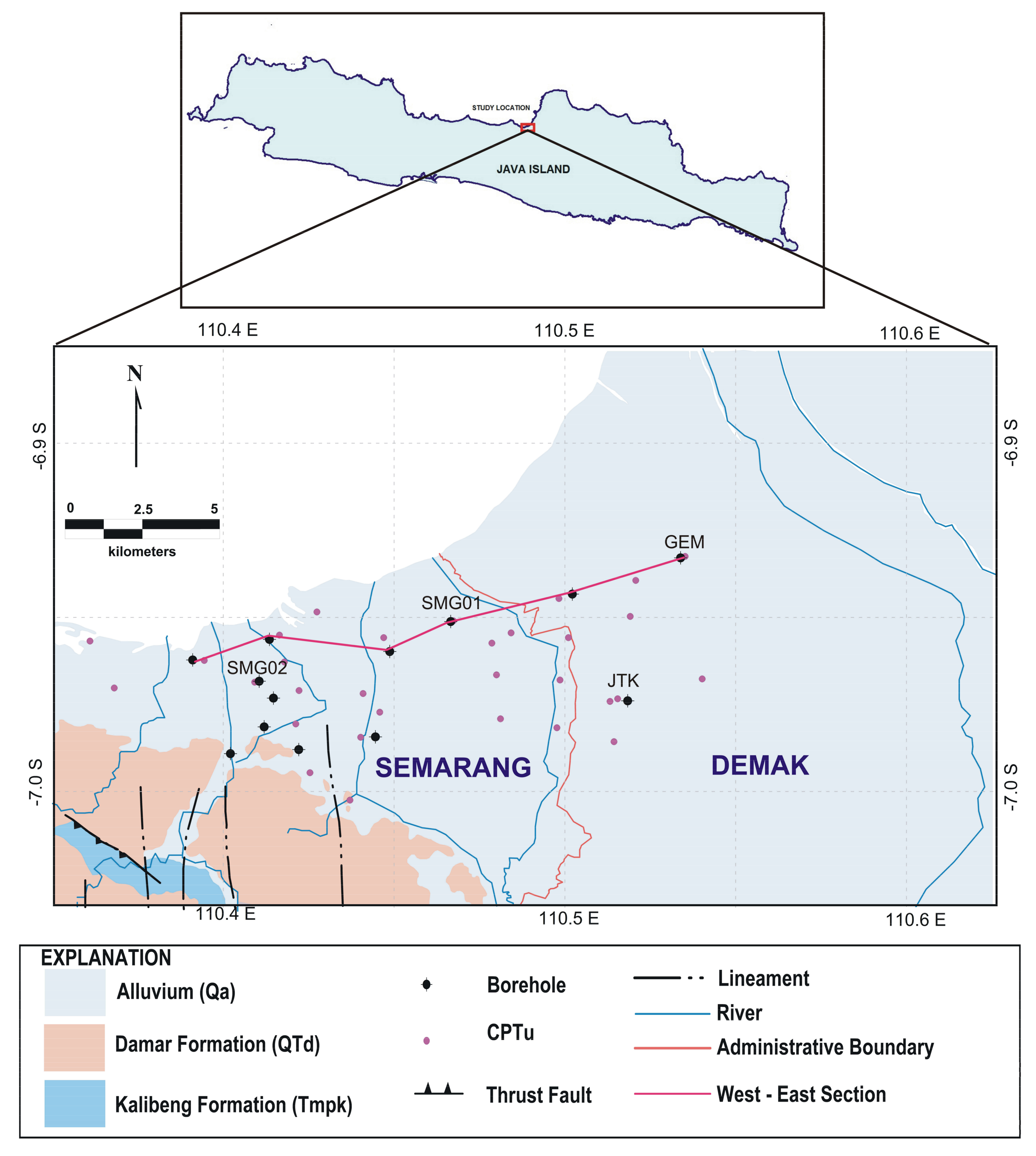A Physical Study of the Effect of Groundwater Salinity on the Compressibility of the Semarang-DemakAquitard, Java Island
Abstract
:1. Introduction
2. Geology and Hydrogeology of the Study Location
3. Materials and Methods
4. Results and Discussion
4.1. Geotechnical Index Properties of Clay
4.2. Mineralogy of Semarang-Demak Clay
4.3. Groundwater Salinity of Semarang-Demak Plain
4.4. Compressibility of Semarang-Demak Clay
4.5. Fabric Analysis of Semarang-Demak Clay
5. Conclusions
Acknowledgments
Author Contributions
Conflicts of Interest
References
- Syvitski, J.P.M.; Kettner, A.J.; Overeem, I.; Hutton, E.W.H.; Hannon, M.T.; Brakenridge, G.R.; Day, J.; Vörösmarty, C.; Saito, Y.; Giosan, L.; et al. Sinking Deltas due to Human Activities. Nat. Geosci. 2009, 2, 681–686. [Google Scholar] [CrossRef]
- Galloway, D.; Jones, D.R.; Ingebritsen, S.E. Land Subsidence in the United States; US Geological Survey: Reston, VA, USA, 1999.
- Barends, F.B.; Brouwer, F.J.; Schröder, F.H. Land Subsidence: Natural Causes, Measuring Techniques, the Groningen Gasfields. In Proceedings of the Fifth International Symposium on Land Subsidence, The Hague, The Netherlands, 16–20 October 1995. [Google Scholar]
- Xu, Y.-S.; Shen, S.-L.; Ren, D.-J.; Wu, H.-N. Analysis of Factors in Land Subsidence in Shanghai: A View Based on a Strategic Environmental Assessment. Sustainability 2016, 8, 573. [Google Scholar] [CrossRef]
- Phi, T.H.; Strokova, L.A. Prediction Maps of Land Subsidence Caused by Groundwater Exploitation in Hanoi, Vietnam. Resour. Technol. 2015, 1, 80–89. [Google Scholar] [CrossRef]
- Phien-Wej, N.; Giao, P.H.; Nutalaya, P. Land Subsidence in Bangkok, Thailand. Eng. Geol. 2006, 82, 187–201. [Google Scholar] [CrossRef]
- Erban, L.E.; Gorelick, S.M.; Zebker, H.A. Groundwater Extraction, Land Subsidence, and Sea-Level Rise in the Mekong Delta, Vietnam. Environ. Res. Lett. 2014, 9. [Google Scholar] [CrossRef]
- Abidin, H.Z.; Andreas, H.; Gumilar, I.; Gamal, M. Land Subsidence and Urban Development in Jakarta (Indonesia) Land Subsidence and Urban Development in Jakarta (Indonesia). In Proceedings of the 7th FIG Regional Conference, Spatial Data Serving People: Land Governance and the Environment, Hanoi, Vietnam, 19–22 October 2009. [Google Scholar]
- Abidin, H.Z.; Andreas, H.; Gumilar, I.; Sidiq, T.P.; Fukuda, Y. Land Subsidence in Coastal City of Semarang (Indonesia): Characteristics, Impacts and Causes. Geomat. Nat. Hazards Risk 2013, 4, 226–240. [Google Scholar] [CrossRef]
- Chaussard, E.; Amelung, F.; Abidin, H.; Hong, S.-H. Sinking Cities in Indonesia: ALOS PALSAR Detects Rapid Subsidence due to Groundwater and Gas Extraction. Remote Sens. Environ. 2013, 128, 150–161. [Google Scholar] [CrossRef]
- Aditiya, A.; Takeuchi, W.; Aoki, Y. Land Subsidence Monitoring by InSAR Time Series Technique Derived from ALOS-2 PALSAR-2 over Surabaya City, Indonesia. IOP Conf. Ser. Earth Environ. Sci. 2017, 98. [Google Scholar] [CrossRef]
- Bakr, M. Influence of Groundwater Management on Land Subsidence in Deltas. Water Resour. Manag. 2015, 29, 1541–1555. [Google Scholar] [CrossRef]
- Shen, S.L.; Ma, L.; Xu, Y.S.; Yin, Z.Y. Interpretation of Increased Deformation Rate in Aquifer IV due to Groundwater Pumping in Shanghai. Can. Geotech. J. 2013, 50, 1129–1142. [Google Scholar] [CrossRef]
- Xu, Y.S.; Yuan, Y.; Shen, S.L.; Yin, Z.Y.; Wu, H.N.; Ma, L. Investigation into Subsidence Hazards due to Groundwater Pumping from Aquifer II in Changzhou, China. Nat. Hazards 2015, 78, 281–296. [Google Scholar] [CrossRef]
- Gambolati, G.; Teatini, P.; Tomasi, L.; Gonella, M. Coastline Regression of the Romagna Region, Italy, due to Natural and Anthropogenic Land Subsidence and Sea Level Rise. Water Resour. Res. 1999, 35, 163–184. [Google Scholar] [CrossRef]
- Teatini, P.; Tosi, L.; Strozzi, T. Quantitative Evidence That Compaction of Holocene Sediments Drives the Present Land Subsidence of the Po Delta, Italy. J. Geophys. Res. Solid Earth 2011, 116, 1–10. [Google Scholar] [CrossRef]
- Holzer, T.L.; Galloway, D.L. Impacts of Land Subsidence Caused by Withdrawal of Underground Fluids in the United States. Rev. Eng. Geol. 2005, 16, 87–99. [Google Scholar] [CrossRef]
- Schmitz, R.M. Can the Diffuse Double Layer Theory Describe Changes in Hydraulic Conductivity of Compacted Clays? Geotech. Geol. Eng. 2006, 24, 1835–1844. [Google Scholar] [CrossRef]
- Meade, R.H. Rearrangement of Particles During the Compaction of Clayey Sediments—Review; Mechanics of Aquifer Systems; Geological Survey Professional Paper 497-B; United States Government Printing Office: Washington, DC, USA, 1964.
- Di Maio, C. Exposure of Bentonite to Salt solution:Osmotic and Mechanical Effects. Geotechnique 1996, 46, 695–707. [Google Scholar] [CrossRef]
- Deng, Y.; Cui, Y.; Tang, A.M.; Nguyen, X.; Deng, Y.; Cui, Y.; Tang, A.M.; Nguyen, X.; Li, X. Investigating the Pore-Water Chemistry Effects on the Volume Change Behaviour of Boom Clay. Phys. Chem. Earth Elsevier 2011, 36, 1905–1912. [Google Scholar] [CrossRef] [Green Version]
- Tiwari, B.; Ajmera, B. Effects of Saline Fluid on Compressibility of Clay Minerals. Environ. Geotech. 2014, 1, 108–120. [Google Scholar] [CrossRef]
- Dutta, J.; Mishra, A.K. Applied Clay Science Consolidation Behaviour of Bentonites in the Presence of Salt Solutions. Appl. Clay Sci. 2016, 120, 61–69. [Google Scholar] [CrossRef]
- Deng, Y.F.; Yue, X.B.; Cui, Y.J.; Shao, G.H.; Liu, S.Y.; Zhang, D.W. Effect of Pore Water Chemistry on the Hydro-Mechanical Behaviour of Lianyungang Soft Marine Clay. Appl. Clay Sci. 2014, 95, 167–175. [Google Scholar] [CrossRef]
- Di Maio, C.; Santoli, L.; Schiavone, P. Volume Change Behaviour of Clays: The Influence of Mineral composition, Pore Fluid Composition and Stress State. Mech. Mater. 2004, 36, 435–451. [Google Scholar] [CrossRef]
- Post, V.E. Fresh and Saline Groundwater Interaction in Coastal Aquifers: Is Our Technology Ready for the Problems Ahead? Hydrogeol. J. 2005, 13, 120–123. [Google Scholar] [CrossRef]
- Bergado, D.T.; Ahmed, S.; Sampaco, C.L.; Balasubramaniam, A.S. Settlements of Bagna-Bangpakong Highway on Soft Bangkok Clay. J. Geotech. Eng. 1990, 116, 136–155. [Google Scholar] [CrossRef]
- Wu, C.-J.; Ye, G.-L.; Zhang, L.-L.; Bishop, D.; Wang, J. Depositional Environment and Geotechnical Properties of Shanghai Clay: A Comparison with Ariake and Bangkok Clays. Bull. Eng. Geol. Environ. 2015, 74, 717–732. [Google Scholar] [CrossRef]
- Xu, Y.S.; Shen, S.L.; Du, Y.J. Geological and Hydrogeological Environment in Shanghai with Geohazards to Construction and Maintenance of Infrastructures. Eng. Geol. 2009, 109, 241–254. [Google Scholar] [CrossRef]
- Luo, C.Y.; Shen, S.L.; Han, J.; Ye, G.L.; Horpibulsuk, S. Hydrogeochemical Environment of Aquifer Groundwater in Shanghai and Potential Hazards to Underground Infrastructures. Nat. Hazards 2015, 78, 753–774. [Google Scholar] [CrossRef]
- Chung, S.G.; Giao, P.H.; Kim, G.J.; Leroueil, S. Geotechnical Properties of Pusan Clays. Can. Geotech. J. 2002, 39, 1050–1060. [Google Scholar] [CrossRef]
- Puzrin, A.M.; Alonso, E.E.; Pinyol, N. Chapter 2 Unexpected Excessive Settlements: Kansai International Airport, Japan. In Geomechanics of Failures; Springer Science+Business Media B.V.: Dordrecht, The Netherlands, 2010; pp. 23–43. [Google Scholar]
- Shen, S.-L.; Xu, Y.-S. Numerical Evaluation of Land Subsidence Induced by Groundwater Pumping in Shanghai. Can. Geotech. J. 2011, 48, 1378–1392. [Google Scholar] [CrossRef]
- Hung, W.-C.; Hwang, C.; Liou, J.-C.; Lin, Y.-S.; Yang, H.-L. Modeling Aquifer-System Compaction and Predicting Land Subsidence in Central Taiwan. Eng. Geol. 2012, 147, 78–90. [Google Scholar] [CrossRef]
- Barry, T. The Soft Soils of Semarang. In Seminar & Workshop Polder Systems in Waterfront Cities September 27–28, 2001; CUR & Universitas Katolik Parahyangan: Bandung, Indonesia, 2001; pp. 1–12. [Google Scholar]
- Tirta, B.A.; Nugroho, M.A.; Parahita, B.; Focks, D.J. Observational Method for More Reliable Settlement Prediction for Reclamation on the Holocene Marine Clay Deposit in Jakarta Bay. In The Third International Conference on Sustainable Infrastructure and Built Environment (SIBE 2017), Bandung, West Java, Indonesia, 26–27 September 2017; EDP Sciences: Les UlisCedex A, France, 2018; pp. 1–9. [Google Scholar]
- Irsyam, M.; Krisnanto, S.; Wardhani, S.P.R. Instrumented Full Scale Test and Numerical Analysis to Investigate Performance of Bamboo Pile-Mattress System as Soil Reinforcement for Coastal Embankment on Soft Clay. In Geotechnical Engineering for Disaster Mitigation and Rehabilitation; Liu, H., Deng, A., Chu, J., Eds.; Springer: Berlin/Heidelberg, Germany, 2008. [Google Scholar]
- Van Schaeck Mathon, F.M.A. Analysis of Groundwater Conditions on the Basis of Existing Data: A Study of the East Semarang- Demak Plain Central Java. In Seminar on Groundwater Development for the Purpose of Irrigation; Ministry of Mining Directorate General of Mining Directorate of Geology: Surabaya, Indonesia, 1975; pp. 1–23. [Google Scholar]
- Thaden, R.E.; Sumardirdja, H.; Richards, P.W. Geological Map of Magelang and Semarang Quadrangles, Java, Scale 1:100.000; Geological Research and Development Centre: Bandung, Indonesia, 1996. [Google Scholar]
- Suwarti, T.; Wikarno, S. Geological Map of Kudus Quadrangle, Java, Scale 1:100.000; Geological Research and Development Centre: Bandung, Indonesia, 1992. [Google Scholar]
- Marsudi. Prediksi LajuAmblesan Tanah Di Dataran Aluvial Semarang, Propinsi Jawa Tengah; Doctoral Dissertation, Institut Teknologi Bandung (ITB): Bandung, Indonesia, 2001. [Google Scholar]
- Bemmelen, R.W.V. The Geology of Indonesia v. 1; MartinusNijhoff: The Hague, The Netherlands, 1949. [Google Scholar]
- Tobing, M.H.L.; Syarief, E.A.; Murdohardono, D. Penyelidikan Geologi Teknik Amblesan Tanah Daerah Semarang Dan Sekitarnya, Propinsi Jawa Tengah; Center for Groundwater Resource and Environmental Geology, Indonesian Geological Agency: Bandung, Indonesia, 2000. [Google Scholar]
- Marfai, M.A.; Almohammad, H.; Dey, S.; Susanto, B.; King, L. Coastal Dynamic and Shoreline Mapping: Multi-Sources Spatial Data Analysis in Semarang Indonesia. Environ. Monit. Assess. 2008, 142, 297–308. [Google Scholar] [CrossRef] [PubMed]
- Taufik Nz, A. Penelitian Hidrogeologi Daerah Imbuhan Airtanah Dengan Metode Isotop Dan Hidrokimia Di Cekungan Airtanah Semarang—Demak ProvinsiJawa Tengah; Center for Groundwater Resource and Environmental Geology, Indonesian Geological Agency: Bandung, Indonesia, 2009. [Google Scholar]
- Brown, G.; Brindley, G.W. X-Ray Diffraction Procedures for Clay Mineral Identificatio. In Crystal Structures of Clay Minerals and their X-Ray Identification; Mineralogical Society London: Twickenham, UK, 1980. [Google Scholar]
- Deepthy, R.; Balakrishnan, S. Climatic Control on Clay Mineral Formation: Evidence from Weathering Profiles Developed. J. Earth Syst. Sci. 2005, 114, 545–556. [Google Scholar] [CrossRef]
- Skempton, A.W. The Consolidation of Clays by Gravitational Compaction. Q. J. Geol. Soc. 1970, 125, 373–411. [Google Scholar] [CrossRef]
- Bradbury, M.H.; Baeyens, B. A Physicochemical Characterisation and Geochemical Modelling Approach for Determining Porewater Chemistries in Argillaceous Rocks. Geochim. Cosmochim. Acta 1998, 62, 783–795. [Google Scholar] [CrossRef]
- Das, B.M. Advanced Soil Mechanics, 3rd ed.; Taylor& Francis: London, UK; New York, NY, USA, 2008; Volume 66. [Google Scholar]
- Mitchell, J.K.; Soga, K. Fundamentals of Soil Behavior, 3rd ed.; John Wiley & Sons, Inc.: Hoboken, NJ, USA, 2005; Volume 40. [Google Scholar]
- Merwe, V.D.; Mechanics, S.; Engineering, F. The weathering of some basic igneous and their engineering properties. Trans. South Afr. Inst. Civ. Eng. 1964, 6, 213–222. [Google Scholar]
- Wong, R.C.K. Swelling and Softening Behaviour of La Biche Shale. Can. Geotech. J. 1998, 35, 206–221. [Google Scholar] [CrossRef]
- Ren, X.; Zhao, Y.; Deng, Q.; Kang, J.; Li, D.; Wang, D. A Relation of Hydraulic Conductivity—Void Ratio for Soils Based on Kozeny-Carman Equation. Eng. Geol. 2016, 213, 89–97. [Google Scholar] [CrossRef]
- Ren, X.W.; Santamarina, J.C. The Hydraulic Conductivity of Sediments: A Pore Size Perspective. Eng. Geol. 2018, 233, 48–54. [Google Scholar] [CrossRef]
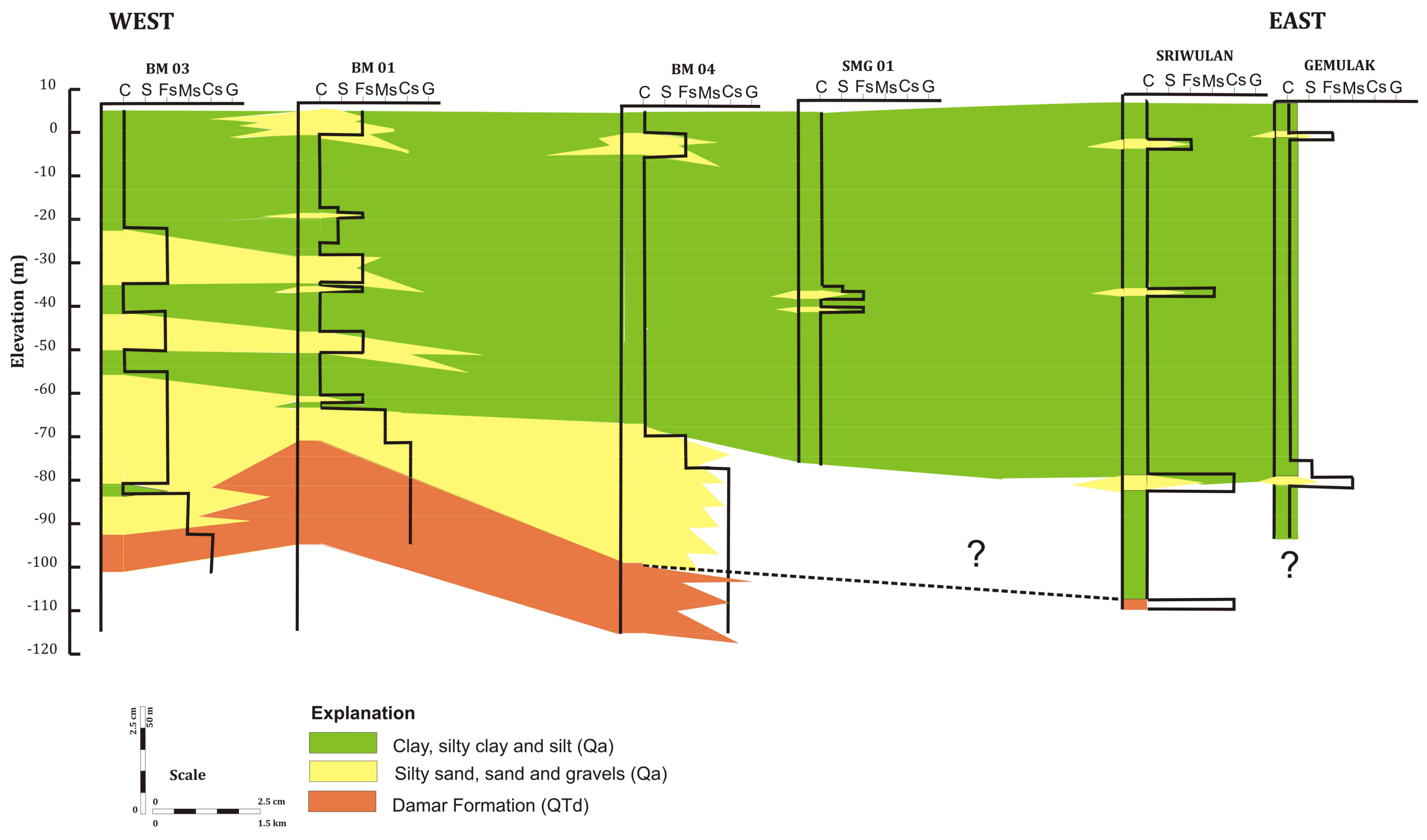


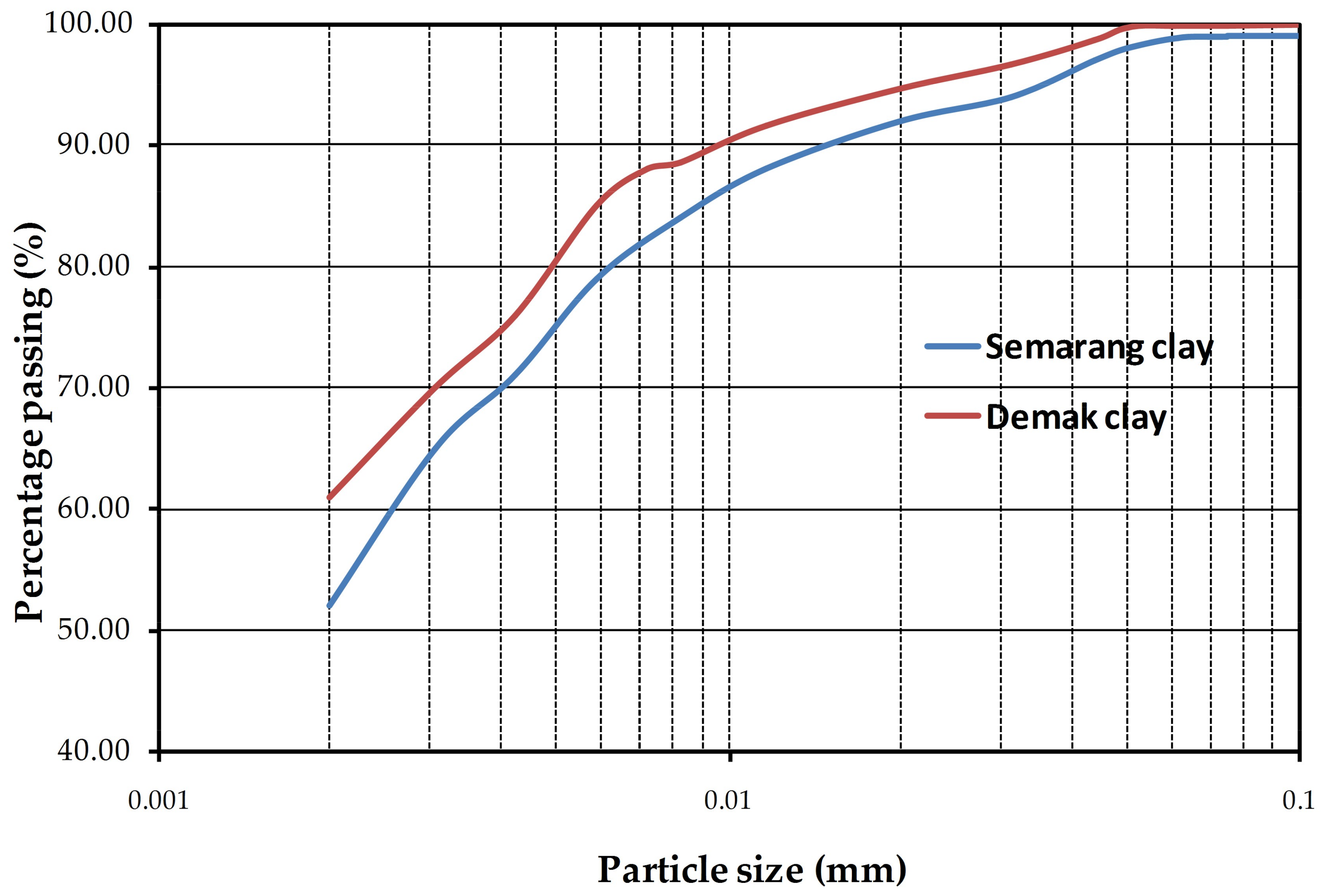

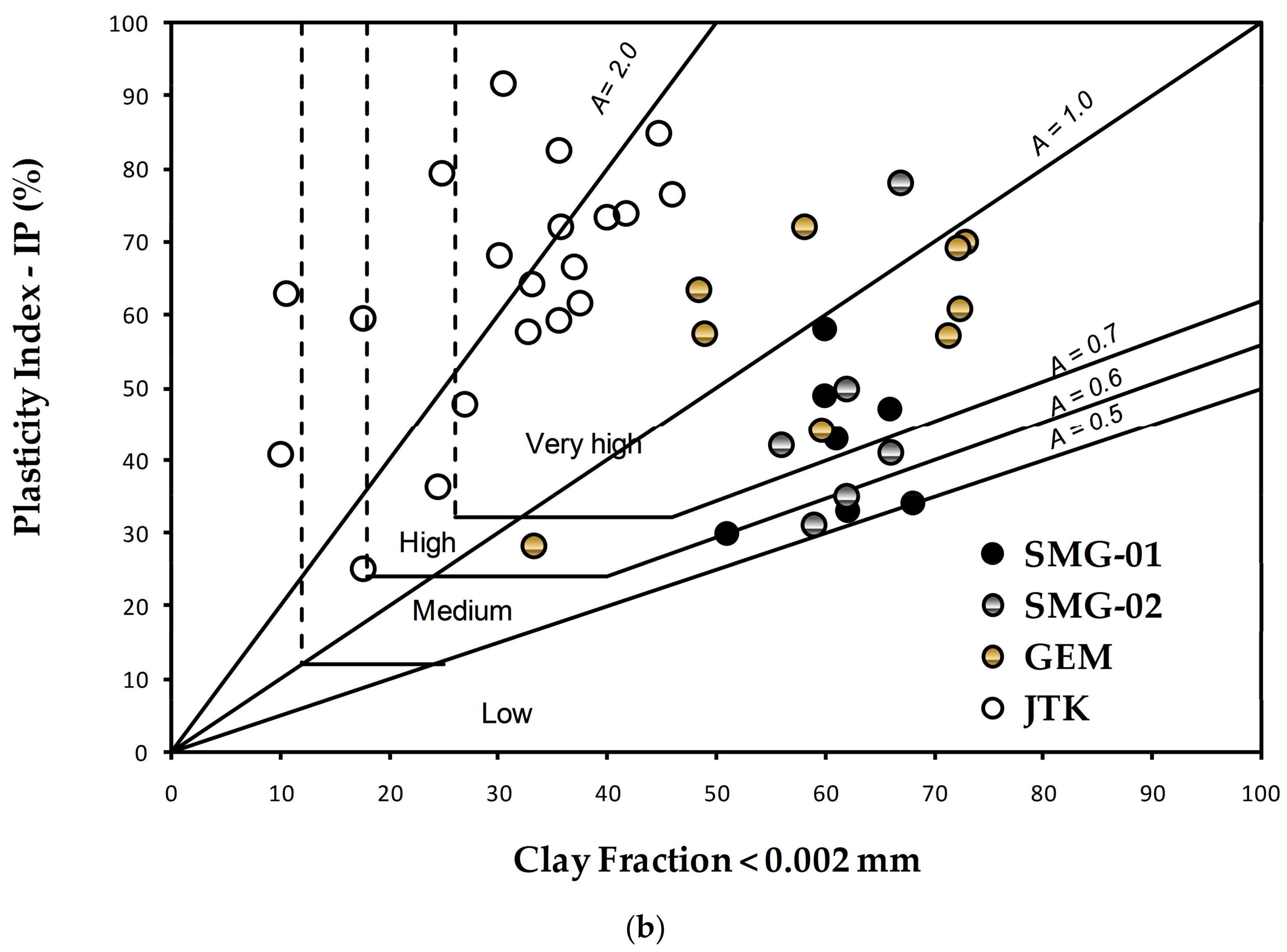
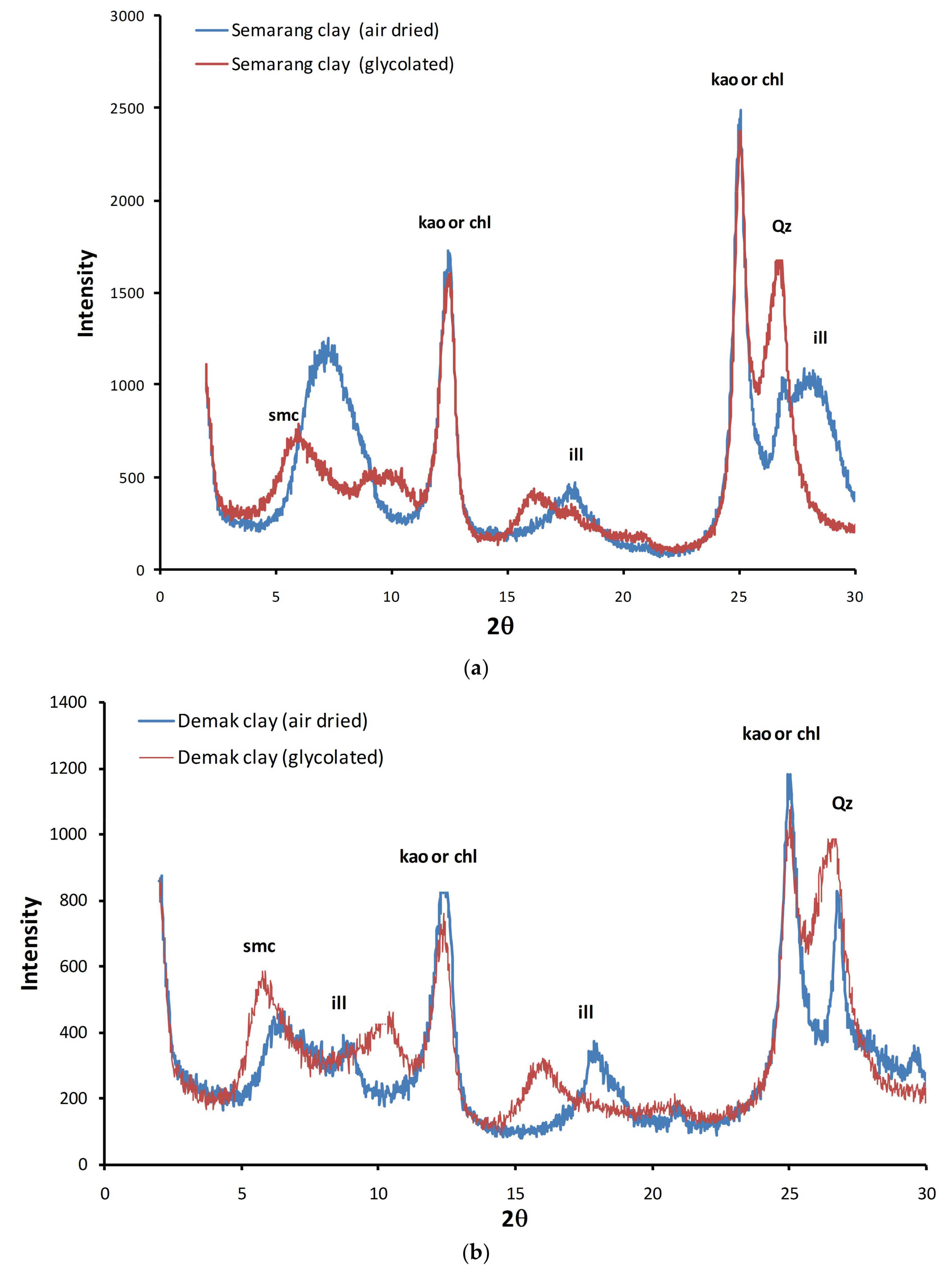

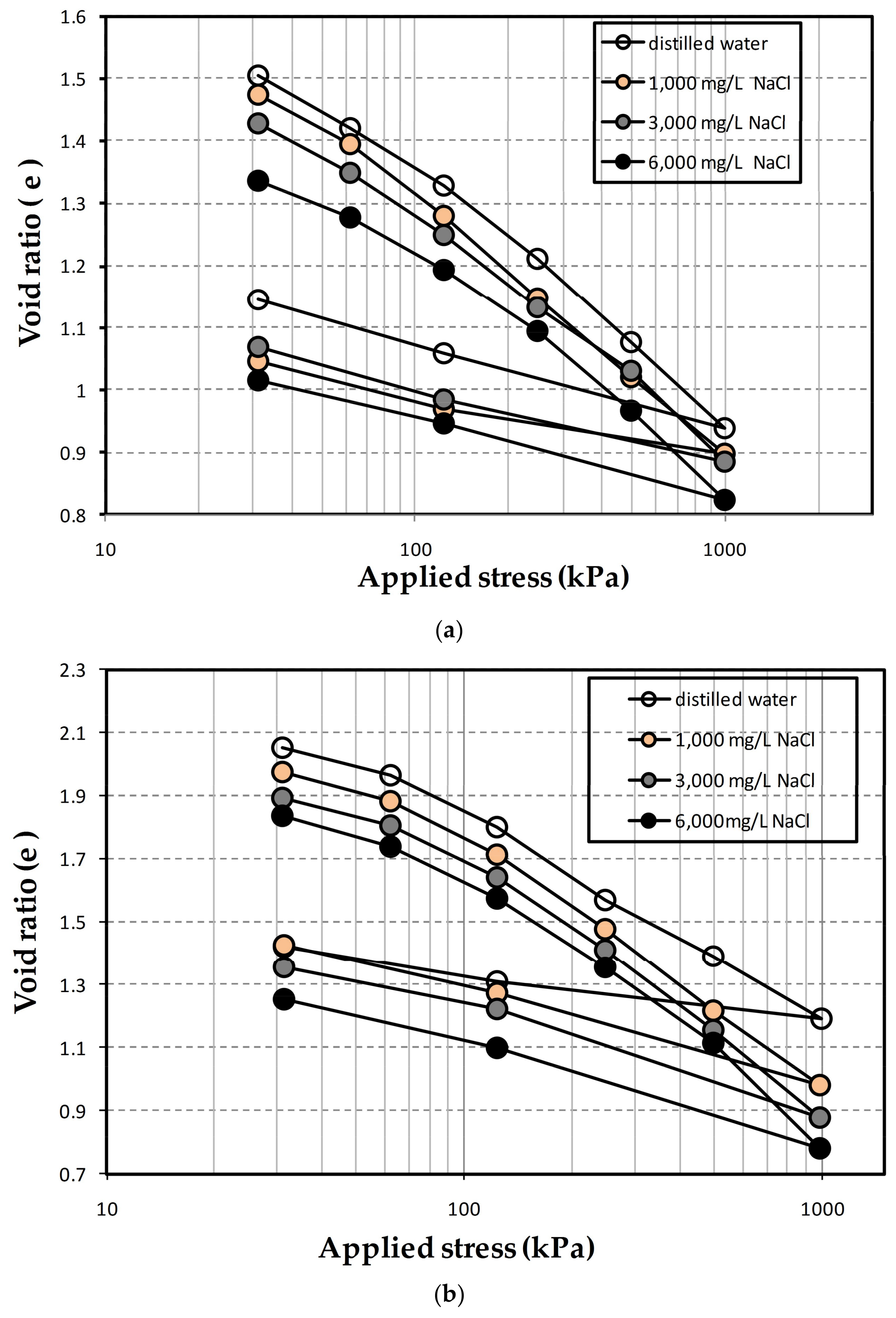

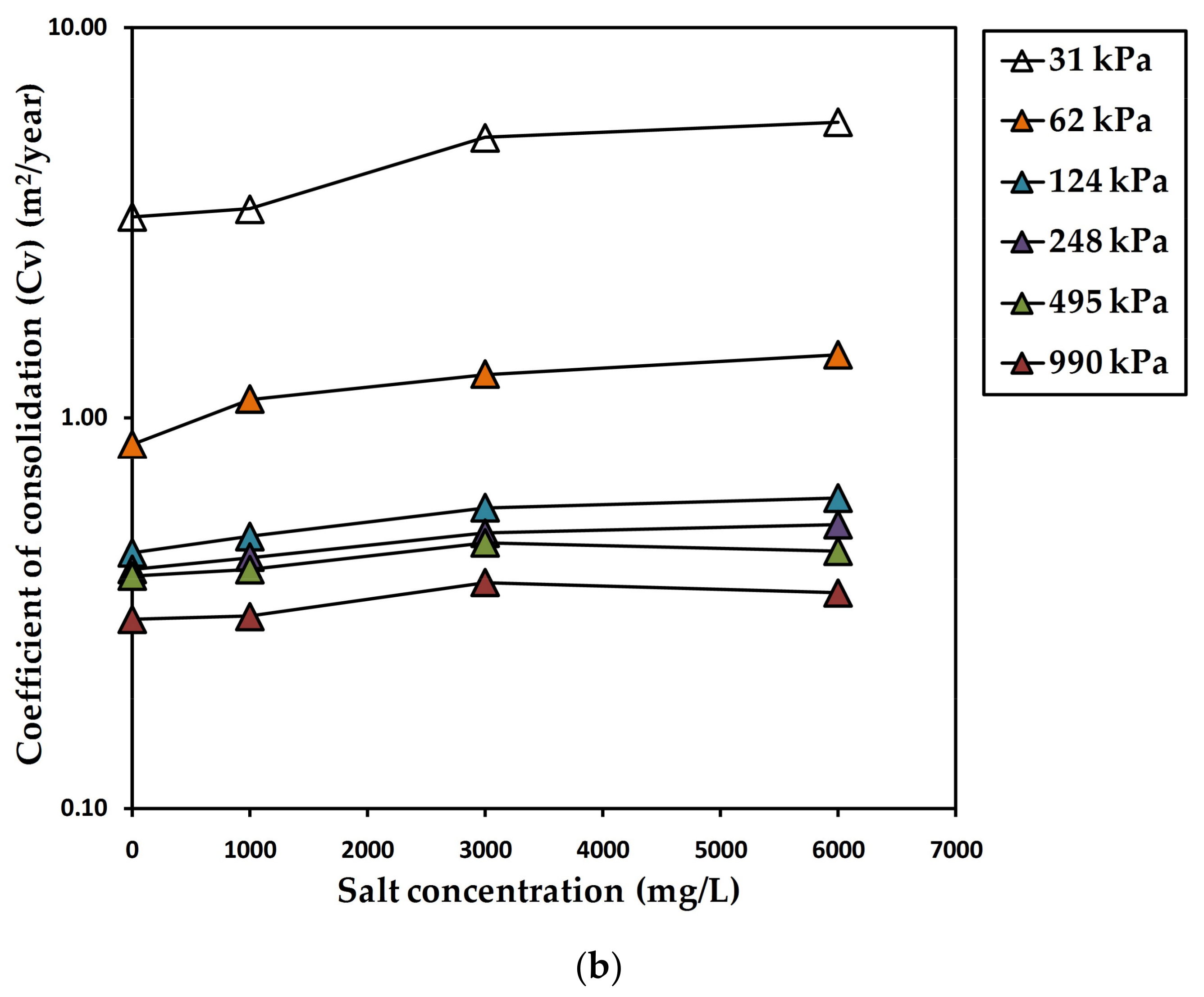


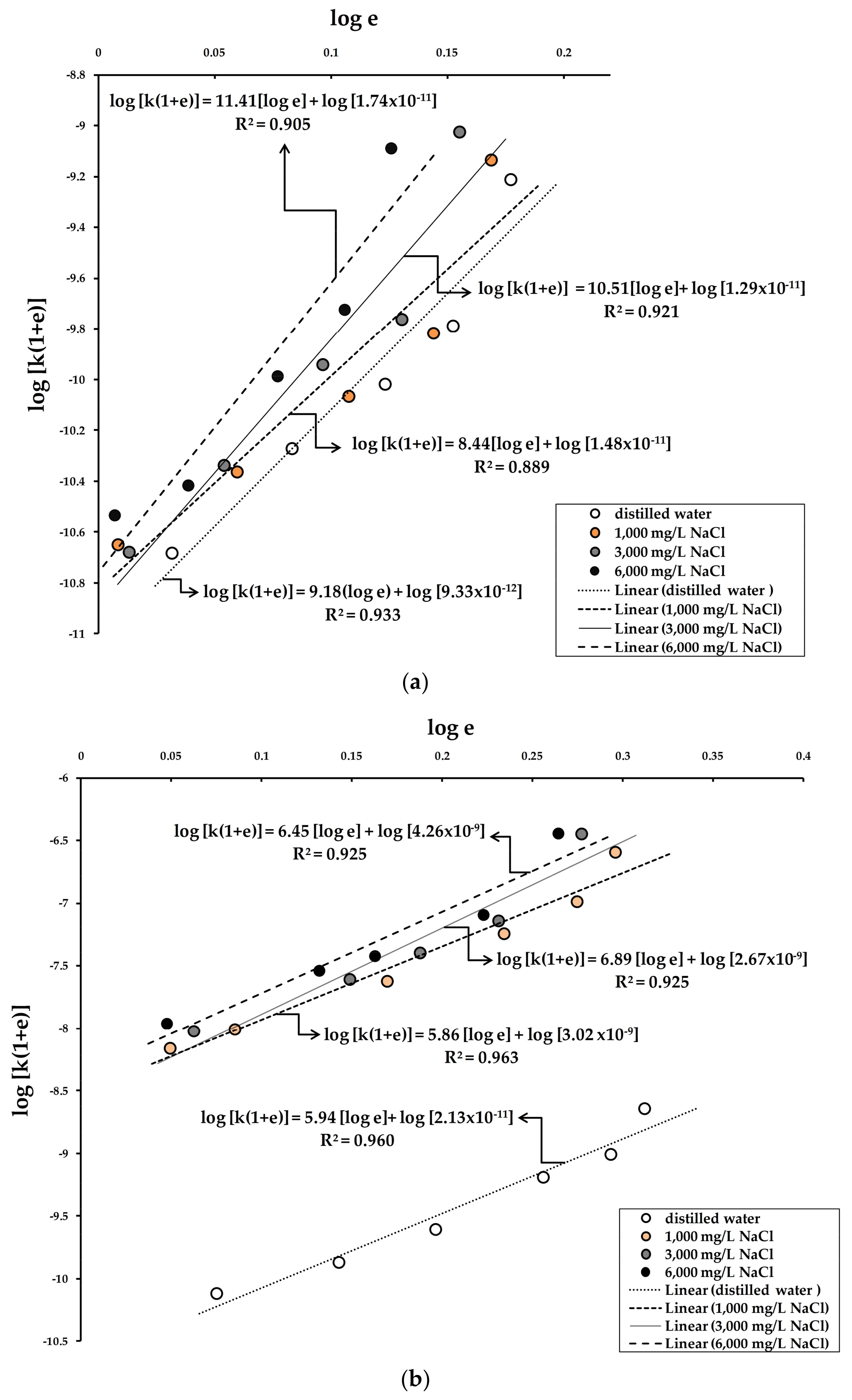

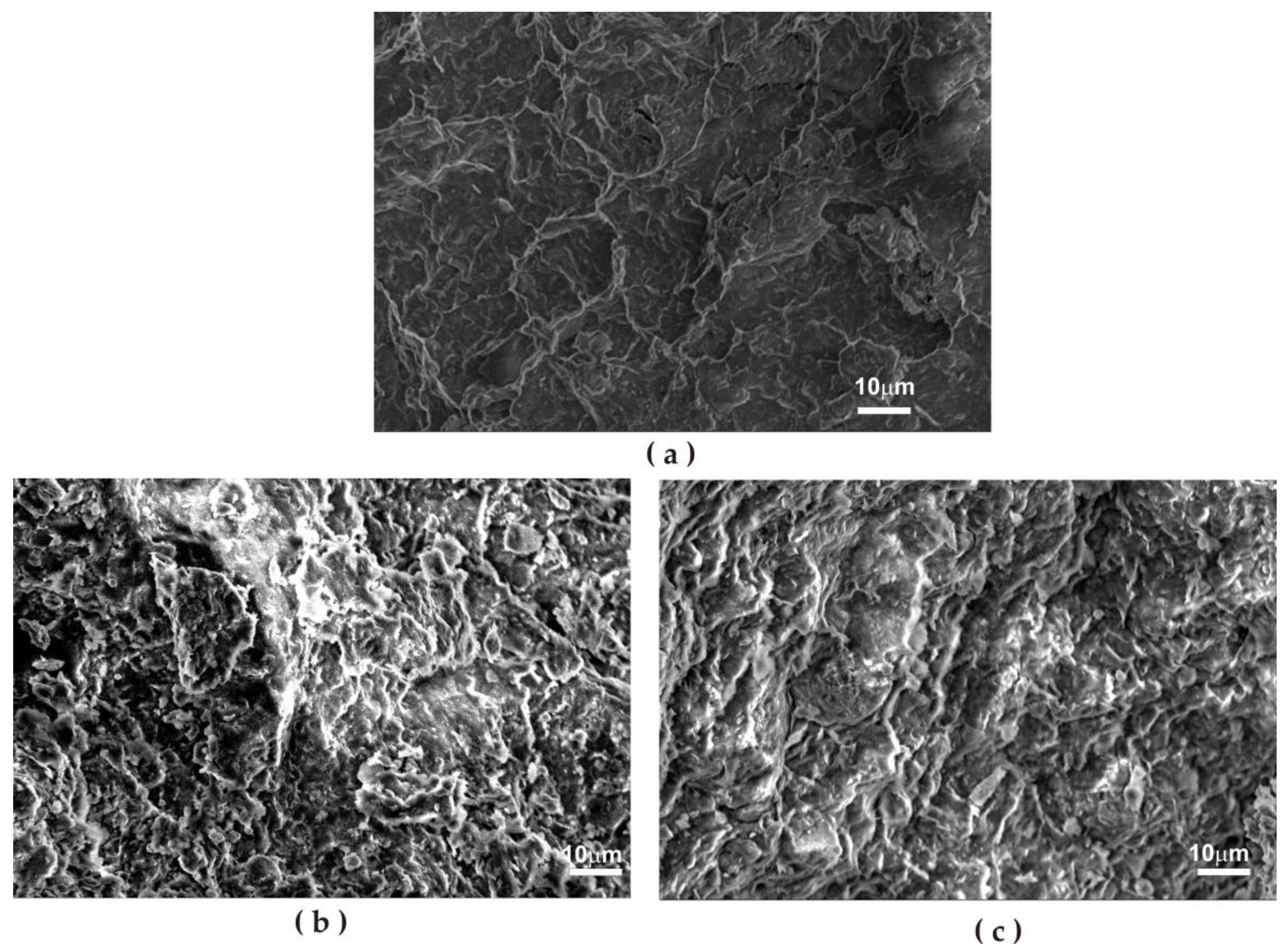
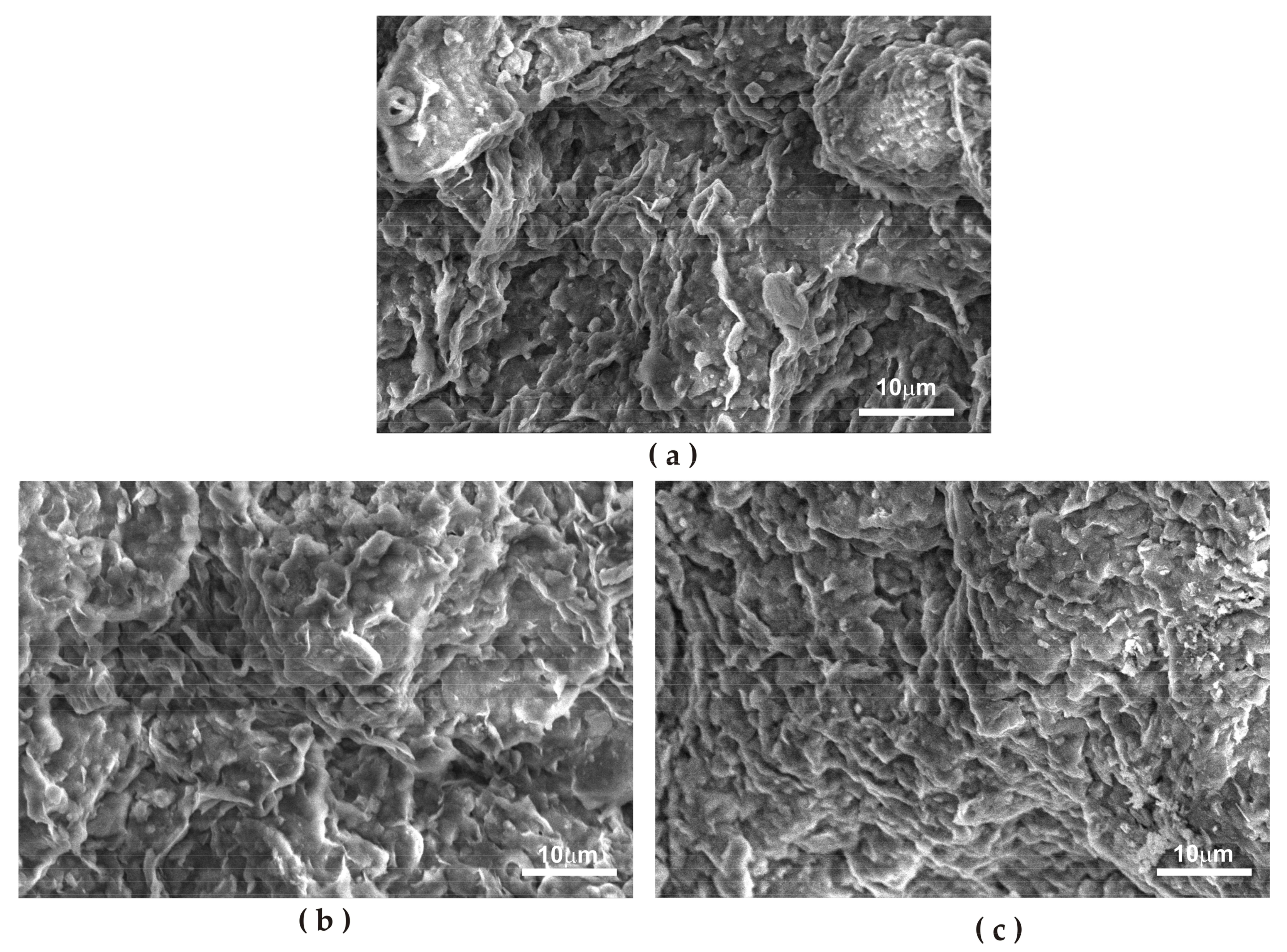
| Borehole | Clay Mineralogy (%) |
|---|---|
| SMG-01 | Smectite (31.0%), illite (29.0%), kaolinite/chlorite (40.0%) |
| SMG-02 | Smectite (37%), illite (22.0%), kaolinite/chlorite (38.0%) |
| GEM | Smectite (58.9%), illite (14.3%), kaolinite/chlorite (24.9%) |
| JTK | Smectite (52.6%), illite (12.7%), kaolinite/chlorite (33.4%) |
| Salt Concentration | cc | cs | Eodo (kPa) | |||
|---|---|---|---|---|---|---|
| (mg/L) | Semarang | Demak | Semarang | Demak | Semarang | Demak |
| 0 | 0.434 | 0.827 | 0.140 | 0.155 | 1468.81 | 1231.08 |
| 1000 | 0.402 | 0.768 | 0.120 | 0.360 | 1495.62 | 1298.97 |
| 3000 | 0.379 | 0.690 | 0.099 | 0.216 | 1586.52 | 1427.45 |
| 6000 | 0.360 | 0.630 | 0.094 | 0.167 | 1716.44 | 1615.13 |
| Salt Concentration | Average cv (m2/year) | Average k (×10−9 m/s) | ||
|---|---|---|---|---|
| (mg/L) | Semarang | Demak | Semarang | Demak |
| 0 | 0.226 | 1.040 | 6.547 | 0.240 |
| 1000 | 0.184 | 1.250 | 7.522 | 0.259 |
| 3000 | 0.276 | 1.400 | 9.286 | 0.304 |
| 6000 | 0.319 | 1.590 | 8.692 | 0.375 |
© 2018 by the authors. Licensee MDPI, Basel, Switzerland. This article is an open access article distributed under the terms and conditions of the Creative Commons Attribution (CC BY) license (http://creativecommons.org/licenses/by/4.0/).
Share and Cite
Sarah, D.; Hutasoit, L.M.; Delinom, R.M.; Sadisun, I.A.; Wirabuana, T. A Physical Study of the Effect of Groundwater Salinity on the Compressibility of the Semarang-DemakAquitard, Java Island. Geosciences 2018, 8, 130. https://doi.org/10.3390/geosciences8040130
Sarah D, Hutasoit LM, Delinom RM, Sadisun IA, Wirabuana T. A Physical Study of the Effect of Groundwater Salinity on the Compressibility of the Semarang-DemakAquitard, Java Island. Geosciences. 2018; 8(4):130. https://doi.org/10.3390/geosciences8040130
Chicago/Turabian StyleSarah, Dwi, Lambok M. Hutasoit, Robert M. Delinom, Imam A. Sadisun, and Taufiq Wirabuana. 2018. "A Physical Study of the Effect of Groundwater Salinity on the Compressibility of the Semarang-DemakAquitard, Java Island" Geosciences 8, no. 4: 130. https://doi.org/10.3390/geosciences8040130




